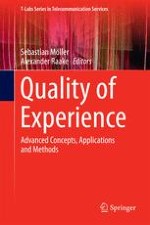2014 | OriginalPaper | Buchkapitel
11. Quality of Experience and Interactivity
verfasst von : Sebastian Egger, Peter Reichl, Katrin Schoenenberg
Erschienen in: Quality of Experience
Aktivieren Sie unsere intelligente Suche, um passende Fachinhalte oder Patente zu finden.
Wählen Sie Textabschnitte aus um mit Künstlicher Intelligenz passenden Patente zu finden. powered by
Markieren Sie Textabschnitte, um KI-gestützt weitere passende Inhalte zu finden. powered by
